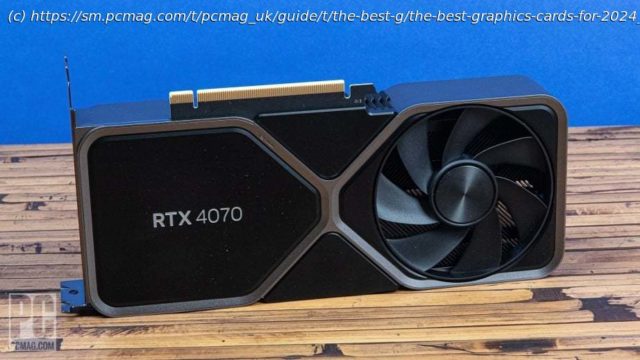Hunting for a new GPU for gaming, multi-display, or something else? Here’s everything you need to know to shop the latest Nvidia GeForce, AMD Radeon, and Intel Arc video cards with confidence. (We’ve tested ’em all.)
Bottom Line:Bottom Line:Asus Dual Nvidia GeForce RTX 4060 OC EditionBottom Line:Bottom Line:Bottom Line:Nvidia GeForce RTX 4090 Founders EditionBottom Line:Bottom Line:Nvidia GeForce RTX 4070Bottom Line:Bottom Line:
First off, what does a graphics card do? And do you really need one?
If you’re looking at any given prebuilt desktop PC on the market, unless it’s a gaming-oriented machine, PC makers will de-emphasize the graphics card in favor of promoting CPU, RAM, or storage options. Indeed, sometimes that’s for good reason; a low-cost PC may not have a graphics card at all, relying instead on the graphics-accelerated silicon built into its CPU (an “integrated graphics processor,” commonly called an “IGP”).
A modern graphics solution, whether it’s a discrete video card or an IGP, handles the display of 2D and 3D content, drawing the desktop, and decoding and encoding video content in programs and games. All of the discrete video cards on the consumer market are built around large graphics processing chips designed by AMD, Intel, or Nvidia. These processors are referred to as “GPUs,” for “graphics processing units,” a term that is also often applied, confusingly, to the graphics card itself.
Now, there’s nothing inherently wrong with relying on an IGP—most business laptops, inexpensive consumer laptops, and budget-minded desktops have them. If you don’t plan to play games or do a lot of content creation work, chances are the IGP will work fine for you—but if you’re a gamer or a creator, the right graphics card is crucial.
Even if you do plan to play games, if you only want to play games in your web browser or older games (from, say, 10-plus years ago), the integrated graphics may also work just fine for you. If your PC doesn’t have an IGP, though, then buying a graphics card is essential to have a functional PC. Some CPUs, notably many AMD Ryzen processors pre-2022, simply don’t have on-chip graphics to fall back on. Gamers will also want to buy a graphics card to play most games, as even most games from a decade ago will run far better on a graphics card than an integrated solution.
Last but not least, a graphics card can also be a valuable upgrade to any office PC, if that PC is used to do a lot of content creation work. Video and image editing programs often have support to use graphics cards to accelerate work, and this can save you a great deal of time and make getting through your work easier.
Graphics cards fall into two distinct classes: consumer cards meant for gaming and light content creation work, and professional workstation cards that are geared toward scientific computing, intense calculations, and artificial intelligence work. This guide, and our reviews, will focus on the former.Hardware Limitations: What Graphics Card Is a Good Fit for My PC?
You should have some idea at this point if you still want to get a graphics card or not. But to pick one that you want to buy, you’ll need to set a goal for yourself and carefully consider the limitations of your PC. Let’s start with the latter: those limitations.
Every PC has a limited amount of room inside its case and a limited amount of power that its power supply can handle. If you don’t check the space available in your PC case before buying a card, you run the risk that it won’t fit, and you’ll be stuck buying a new case or having to return your card for another (smaller) one.
If you don’t check how much power your PC’s power supply can support before buying a GPU, things can go even worse. If you buy a card that needs more power than your PSU can handle, you could potentially damage your power supply or other parts by repeatedly pushing the power supply past its safe limit. Your system may also seem to work fine at times, but may crash periodically whenever the power draw rises too high.
These problems are an inconvenience at the least, and they can be seriously troublesome issues at the worst. Both are easy to avoid if you simply check what your PC can support first before buying. If you are building a new PC from scratch, you’ll also want to make sure you buy a power supply and case accordingly that can handle all of your parts.
Nvidia and AMD both outline recommended power supply wattage for each of their graphics card families. These estimates are typically quite conservative and above what is actually needed, but you should follow them nonetheless to avoid any issues.
Your system needs to have a PSU that’s up to the task of giving a new card enough juice. This is something to be especially wary of if you’re putting a high-end video card in a pre-built PC that was equipped with a low-end card, or no card at all. Doubly so if it’s a budget-minded or business system; these PCs tend to have underpowered or minimally provisioned PSUs.
The two most important factors to be aware of here are the number of six-pin and eight-pin cables on your PSU, and the maximum wattage the PSU is rated for. Most cards beyond the most basic will require a six-pin cable, an eight-pin cable, or some combination of the two to provide working power to the card. (The very lowest-end cards draw all the power they need from the PCI Express slot they plug into.) Make sure you know what your card needs in terms of connectors.
We’ve seen some changes here of late, as some of the GeForce RTX cards require a special adapter (it comes in the box) to turn two eight-pin PSU connectors into a single 12-pin one on the card. Also, a few other high-end monster cards now require a whopping three eight-pin connectors to suck down the required juice. Check that power supply (and the recommendation details for the specific card you are looking at) before dropping coin.
Last, if you are upgrading an existing computer, it’s also important to know that a graphics card can end up bottlenecked and perform slower than expected if the rest of the system it is installed into isn’t fast enough to keep up. This mostly applies to the CPU that you pair the graphics card with, and to a far lesser extent the system’s RAM. We can’t give you ironclad, simple recommendations here, as faster GPUs will need faster CPUs, and slower graphics cards will work fine with slower processors. (Look to individual card reviews for more detail on that aspect.) We will give more direct advice here on our individual card recommendations, though.Meet the Card Players: AMD, Intel, and Nvidia
The graphics card market is dominated by AMD and Nvidia, with chip giant Intel entering the fray in late 2022 with its own line of desktop graphics cards sold under the Intel Arc brand.Intel: The Arc Newcomer
Intel’s top-end graphics card at the moment is the Intel Arc A770, followed by the Intel Arc A750 in the midrange and the Arc A580 and Arc A380 at the low end of the spectrum. Intel, so far, has been pressing to make inroads via aggressive pricing. Early inconsistencies in performance and early driver issues have hampered the company’s success so far in this market. But the Arc A580, the most recent Arc card we have reviewed, is a budget winner, showing promise thanks to a year of diligent, consistent driver improvements on Intel’s part.
Being the CPU giant it is, Intel has been producing integrated graphics processors that work on its chips since the late 1990s, and has enjoyed a long history in the industry. But it has a lot of ground to cover before it can catch up with AMD and Nvidia in the dedicated-graphics world. (Graphics cards are often called “dedicated graphics,” to distinguish them from integrated graphics on CPUs.) Nonetheless, its cards still might be worth considering under the right circumstances, especially as subsequent graphics drivers hit the street in coming months and years.AMD: Radeon Is in the Running
AMD sells consumer graphics cards as part of its AMD Radeon RX product line, and it has workstation cards that are sold under the AMD Radeon Pro and AMD Radeon Instinct brands.
AMD’s Radeon RX 7000-series cards, its latest, first launched in December 2022 with the Radeon RX 7900 XTX and slightly cheaper Radeon RX 7900 XT. This pair was followed by the AMD Radeon RX 7600, the Radeon RX 7700 XT, and the Radeon RX 7800 XT to round out AMD’s 7000-series lineup. Most models of the older Radeon RX 6000 series remain on the market, as well, with meaningful discounts that keep them recommendable in select scenarios, especially if the newer models are too costly for your budget.Nvidia: GeForce Is the Dominant Force
Nvidia splits its products in a similar manner, with the company’s mainstream consumer graphics products branded as Nvidia GeForce GTX or RTX, and its workstation cards branded as RTX A Series (formerly Quadro). Nvidia also launched new cards at the end of 2022, with the Nvidia GeForce RTX 4090 coming out in October. The RTX 40 series has seen more additions since then, but prices on older GeForce RTX 30-series cards have remained surprisingly high. This has effectively made the RTX 30-series cards less recommendable, as you can usually get the newer and faster RTX 40-series ones for not a whole lot more cash. But, now and then, you can find the older cards on a good sale that makes them worth picking up. What Are ‘Board Partners’ and ‘Reference Designs’?
AMD, Intel, and Nvidia all design the GPUs that bear their names. The chip makers also produce a limited number of full graphics cards themselves and sell directly to consumers. But most graphics cards are created by other companies that are referred to as “board partners.”
Board partners may not design and make the actual graphics chips at the core of their cards, but they nonetheless play a pivotal role in the production of graphics cards. They design the physical cards, the power systems, and the thermal solutions that make these cards possible. You’ll see a lot of board partners at this point as you shop, including ASRock, Asus, Biostar, Colorful, Galax, Gigabyte, Inno3D, MSI, Palit, PowerColor, PNY, Sapphire, XFX, and Zotac.
The big three GPU makers often work up what are known as “reference designs” for their video cards, a standardized version of a card built around a given GPU. Sometimes these reference-design cards are sold directly by the GPU maker; more often, though, the chip makers work with the board partners to market and incorporate their GPUs into cards the partners sell. That’s why you’ll see, for example, GeForce RTX 4060 cards sold by a host of companies that are not actually Nvidia itself.
Depending on the graphics chip in question, these board partners may sell their own self-branded versions of the reference card (adhering to the design and specifications set by the GPU maker), or they will fashion their own custom products, with different cooling-fan designs, slight overclocking done from the factory, or features such as LED mood illumination.






